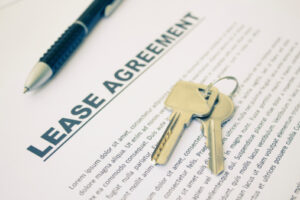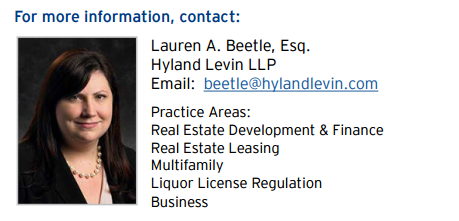 This article explores why you should always carefully review estoppel certificates when leasing commercial property. If you work in commercial real estate or are a tenant or landlord of commercial property, you will inevitably deal with estoppel certificates. Estoppel certificates are common in commercial leasing and real estate transactions, and are often considered “form” documents to be signed by a tenant as a matter of course. Executing an estoppel certificate, however, can have significant consequences to tenants, and thus, tenants should carefully review estoppel certificates and understand and confirm the accuracy of its terms before signing.
This article explores why you should always carefully review estoppel certificates when leasing commercial property. If you work in commercial real estate or are a tenant or landlord of commercial property, you will inevitably deal with estoppel certificates. Estoppel certificates are common in commercial leasing and real estate transactions, and are often considered “form” documents to be signed by a tenant as a matter of course. Executing an estoppel certificate, however, can have significant consequences to tenants, and thus, tenants should carefully review estoppel certificates and understand and confirm the accuracy of its terms before signing.
Prior to evaluating the specifics of estoppel certificates, we should start with what estoppels are and why certain parties request them. An estoppel certificate is a written confirmation typically signed by a tenant or mortgagee certifying for another party’s benefit (e.g. the lender or purchaser) that certain facts are accurate and complete as of a certain date. Estoppel certificates are most frequently requested in connection with the purchase, financing or refinancing of commercial property. Estoppel certificates serve the dual purposes of (a) providing independent verification from the tenant of the leasing economics and confirmation of certain information about the tenant, lease and leased premises so that the lender or purchaser can assess potential liabilities they may face as, and if, they become the owner of the property, and (b) “estopping,” or prohibiting, a tenant from making claims contrary to the statements contained in the estoppel certificate at a later date.
How tenants should review estoppel certificates
A tenant’s review of an estoppel certificate should always begin with the underlying lease. The majority of commercial leases include an estoppel certificate provision requiring a tenant to execute and deliver an estoppel certificate at landlord’s request. The time period for doing so is usually rather short (10 or 15 days is quite common). Some leases provide that if an estoppel certificate is not returned by a certain date, the landlord may sign it as tenant’s agent or attorney-in-fact. Others state that if an estoppel certificate is not timely returned, everything contained therein will be deemed true, or an estoppel may provide for monetary penalties or be deemed an event of default for failure to return. Accordingly, tenants should be mindful of returning estoppels timely in accordance with their lease terms.
In most instances, the form of estoppel certificate will be prepared by the lender’s or purchaser’s counsel. Facts typically confirmed in an estoppel include: (i) the name of the tenant, a description of the lease and identification of any lease amendments or modifications (oral or written); (ii) confirmation of the date through which rent has been paid and concerning any pre-paid rents, operating expenses, or the fees; (iii) the lease term including commencement, expiration and any extension or renewal options; (iv) whether the tenant has any purchase options, rights of first refusal, or expansion or relocation rights; (v) security deposits; (vi) whether an event has occurred that constitutes a default under the lease or whether any notice of breach of lease has been delivered; (vii) confirmation regarding any construction, tenant improvement, fit-out or other allowances and/or work; (viii) confirmation that the lease remains in full force and effect; (ix) confirmation that the tenant remains in sole possession of the property and has not assigned, sublet, pledged or mortgaged the lease or the premises; (x) whether there is any free rent or unexpired concessions or abatement of rent; and (xi) whether the tenant has any defenses to performing its obligations under the lease. A statement concerning the tenant’s use of hazardous substances at the premises or whether it has violated any environmental laws is also occasionally, but less frequently, included. These items may be specified in the estoppel certificate provision of the lease. Some leases include an agreed-upon form of estoppel certificate attached as an exhibit to the lease, and many larger retail tenants have their own form which is used across their portfolio often without variation. Despite the forgoing, it is not uncommon for lenders, and occasionally purchasers, to ignore the agreed-upon form or expand the list of facts to be confirmed in an estoppel.
Questions arising when tenants review estoppel certificates
From a practical perspective, the questions are what should a tenant be careful about confirming and how should it proceed for the review estoppel certificates. The first and most essential step is for someone familiar with the lease and the tenant’s operations at the premises to confirm that all relevant documents governing the leasing relationship are properly identified in the estoppel (including any amendments, addenda, revised exhibits and side letters or agreements), and that the factual items stated in the certificate are true and correct, and if not, to modify those statements as necessary.
The next step is determining whether there are statements made that need objection. Tenants will want to object to provisions which constitute representations or warranties beyond the scope given under the lease, which expand the duties of the tenant under the lease or which otherwise modify the lease. Tenants should also avoid statements about matters that fall principally within the landlord’s knowledge, such as information or knowledge about landlord mortgages, prior loans or defaults (other than those pertaining to the tenant’s lease or other tenants’ activities).
These objections can be raised by striking the objectionable language completely or limiting the statements to the terms of the lease. Adding knowledge qualifiers to statements about property or environmental conditions may also be appropriate. Because of the tight time constraints involved with estoppel certificates, it often makes sense for a tenant to mark-up the estoppel with the corrected factual statements or language and quickly return the signed document to the landlord. If the marked changes are problematic, the lender, purchaser or landlord will advise and modifications can be negotiated without the tenant failing to meet its obligation to provide a signed estoppel under the lease. Moreover, while it is critical that a tenant ensure an estoppel certificate is factually accurate and consistent with its lease, it is in neither party’s interest to unnecessarily or unreasonably object to an estoppel certificate. Since the landlord and tenant will have an ongoing relationship under the lease following the delivery of the estoppel certificate, being timely in one’s response and limiting objections to material adverse statements, will serve both parties well. Like most leasing issues, responsiveness and communication are key to delivering proper estoppel certificates.
Lauren A. Beetle, Esq. is a partner with Hyland Levin LLP in Marlton, New Jersey. She regularly represents lenders, buyers and sellers in real estate, business and financing transactions.



